An AC-DC Coordinated Scheme for Cascaded Hybrid High-Voltage Direct Current to Suppress Wind Power Fluctuations
Abstract
:1. Introduction
2. The Cascaded Hybrid HVDC System
2.1. Cascaded Hybrid HVDC System’s Topology
2.2. Hybrid HVDC Control Scheme of the LCC Converter
2.3. Hybrid HVDC Control Schemes of the MMC Converter
3. Schemes of Coordination Control
3.1. Control Schemes of Coordinated Active Power
3.1.1. MMC3 Supplementary Control Given Wind Power Fluctuations
3.1.2. DC Voltage Coordination Scheme Given the Supplementary Control
3.1.3. The Completed Active Coordination Scheme
3.2. Coordinated Reactive Power Control
3.2.1. The Dynamic Limiter
3.2.2. The Coordination Scheme with the Dynamic Limiter
4. Case Study
4.1. Simulations of Static UI Characteristics
4.2. Simulation Control of Coordinated Active Power
4.2.1. The Supplementary Control Verification When Wind Power Fluctuates
4.2.2. Coordinated DC Voltage Control Verification Considering Supplementary Control
4.2.3. Stability Verification of Long-Term Supplementary Control
4.3. Simulations of Dynamic Limiters
5. Conclusions
- The basic control characteristics of the hybrid HVDC system are clarified. Specifically, the design of the supplementary active power control can effectively suppress frequency deviations generated within the near-land regional power grid during wind power disturbances. This mechanism redirects wind power disturbances away from the cascaded multi-infeed MMC inverters, redirecting them instead to other regional power grids. Through this process, other MMCs assume the responsibility of managing these fluctuations, ultimately enhancing the overall system stability.
- In CV control, this coordination scheme ensures the stability of the DC voltage even under the overload condition of the original VSC. This ensures that the hybrid HVDC system remains stable, while simultaneously enhancing its ability to suppress fluctuations, thus improving overall system performance.
- The dynamic limiter is remarkably effective in improving voltage stability. With the aid of this proposed limiter, a significant amount of additional reactive power can be generated, further facilitating the smooth integration of renewable energy sources into the grid.
Author Contributions
Funding
Data Availability Statement
Conflicts of Interest
Abbreviations
| Abbreviation | Full Name |
| AC | Alternating Current |
| DC | Direct Current |
| LCC | Line Commutated Converter |
| VSC | Voltage Sourced Converter |
| HVDC | High-Voltage Direct Current |
| MMC | Modular Multilevel Converter |
| LCC-HVDC | Line Commutated Converter-based High-Voltage Direct Current |
References
- Xue, Y.; Ge, F.; Zhao, Z.; Zhang, Z.; Xing, F. Control strategy for hybrid LCC-C-MMC HVDC system under AC fault at rectifier side. J. Eng. 2019, 2019, 3259–3263. [Google Scholar] [CrossRef]
- Qahraman, B. Series/Parallel Hybrid VSC-LCC for HVDC Transmission Systems. Ph.D. Dissertation, Department of Electrical and Computer Engineering, University of Manitoba, Winnipeg, MB, Canada, 2010. [Google Scholar]
- Lou, B.; Zhou, H.; Xu, Z.; Wang, S.; Xu, Y. Fault response comparison of LCC–MMC hybrid topologies and conventional HVDC topology. J. Eng. 2019, 2019, 2068–2073. [Google Scholar] [CrossRef]
- Yang, R.; Xiang, W.; Lin, W.; Wen, J. Hybrid ultra-HVDC system with LCC and cascaded hybrid MMC. J. Eng. 2019, 2019, 1112–1116. [Google Scholar] [CrossRef]
- Torres-Olguin, R.E.; Garces, A.; Molinas, M.; Undeland, T. Integration of Offshore Wind Farm Using a Hybrid HVDC Transmission Composed by the PWM Current-Source Converter and Line-Commutated Converter. IEEE Trans. Energy Convers. 2013, 28, 125–134. [Google Scholar] [CrossRef]
- Jiang, Q.; Li, B.; Liu, T.; Blaabjerg, F.; Wang, P. Study of Cyber Attack’s Impact on LCC-HVDC System With False Data Injection. IEEE Trans. Smart Grid 2023, 14, 3220–3231. [Google Scholar] [CrossRef]
- Zeng, R.; Xu, L.; Yao, L.; Finney, S.J.; Wang, Y. Hybrid HVDC for Integrating Wind Farms With Special Consideration on Commutation Failure. IEEE Trans. Power Deliv. 2016, 31, 789–797. [Google Scholar] [CrossRef]
- Rao, H.; Zhou, Y. Key technologies of ultra-high voltage hybrid LCC-VSC MTDC systems. CSEE J. Power Energy Syst. 2019, 5, 365–373. [Google Scholar] [CrossRef]
- Haleem, N.M.; Rajapakse, A.D.; Gole, A.M.; Fernando, I.T. Investigation of Fault Ride-Through Capability of Hybrid VSC-LCC Multi-Terminal HVDC Transmission Systems. IEEE Trans. Power Deliv. 2019, 34, 241–250. [Google Scholar] [CrossRef]
- Taherzadeh, E.; Radmanesh, H.; Javadi, S.; Gharehpetian, G.B. Circuit breakers in HVDC systems: State-of-the-art review and future trends. Prot. Control Mod. Power Syst. 2023, 8, 1–16. [Google Scholar] [CrossRef]
- Xiao, H.; Li, Y.; Duan, X. Efficient approach for commutation failure immunity level assessment in hybrid multi-infeed HVDC systems. J. Eng. 2017, 2017, 719–723. [Google Scholar] [CrossRef]
- Guo, C.; Zhang, Y.; Gole, A.M.; Zhao, C. Analysis of Dual-Infeed HVDC With LCC–HVDC and VSC–HVDC. IEEE Trans. Power Deliv. 2012, 27, 1529–1537. [Google Scholar] [CrossRef]
- Liu, Y.; Chen, Z. A Flexible Power Control Method of VSC-HVDC Link for the Enhancement of Effective Short-Circuit Ratio in a Hybrid Multi-Infeed HVDC System. IEEE Trans. Power Syst. 2013, 28, 1568–1581. [Google Scholar] [CrossRef]
- Xiao, H.; Li, Y.; Shi, D.; Chen, J.; Duan, X. Evaluation of Strength Measure for Static Voltage Stability Analysis of Hybrid Multi-Infeed DC Systems. IEEE Trans. Power Deliv. 2019, 34, 879–890. [Google Scholar] [CrossRef]
- Ni, X.; Gole, A.M.; Zhao, C.; Guo, C. An Improved Measure of AC System Strength for Performance Analysis of Multi-Infeed HVdc Systems Including VSC and LCC Converters. IEEE Trans. Power Deliv. 2018, 33, 169–178. [Google Scholar] [CrossRef]
- Zou, C.; Rao, H.; Xu, S.; Li, Y.; Li, W.; Chen, J.; Zhao, X.; Yang, Y.; Lei, B. Analysis of Resonance Between a VSC-HVDC Converter and the AC Grid. IEEE Trans. Power Electron. 2018, 33, 10157–10168. [Google Scholar] [CrossRef]
- Wang, L.; Yang, Z.-H.; Lu, X.-Y.; Prokhorov, A.V. Stability Analysis of a Hybrid Multi-Infeed HVdc System Connected Between Two Offshore Wind Farms and Two Power Grids. IEEE Trans. Ind. Appl. 2017, 53, 1824–1833. [Google Scholar] [CrossRef]
- Chang, Y.; Cai, X. Hybrid Topology of a Diode-Rectifier-Based HVDC System for Offshore Wind Farms. IEEE J. Emerg. Sel. Top. Power Electron. 2019, 7, 2116–2128. [Google Scholar] [CrossRef]
- Chen, X.; Sun, H.; Wen, J.; Lee, W.-J.; Yuan, X.; Li, N.; Yao, L. Integrating Wind Farm to the Grid Using Hybrid Multiterminal HVDC Technology. IEEE Trans. Ind. Appl. 2011, 47, 965–972. [Google Scholar] [CrossRef]
- Chen, Y.; Yin, X.; Wang, X.; Yin, X.; Cao, W.; Pan, Y. A New Kind of Hybrid UHVDC System Dedicated for Long-Distance Power Delivery and Regional Power Grids Back-to-Back Hierarchical Interconnection. In Proceedings of the 2019 10th International Conference on Power Electronics and ECCE Asia (ICPE 2019—ECCE Asia), Busan, Republic of Korea, 27–30 May 2019; pp. 1–7. [Google Scholar]
- Liu, S.; Yu, J.; He, Z.; Liu, Z.; Guo, X.; Lin, C.; Liu, J. Research on the topology and characteristic of multi-terminal HVDC based on VSC and LCC. Proc. CSEE 2018, 38, 2980–2988. [Google Scholar]
- Arrillaga, J. High Voltage Direct Current Transmission. January 1998. Available online: https://books.google.dk/books?id=I2mdgdflTQUC&printsec=frontcover&dq=High+voltage+direct+current+transmission&hl=zh-CN&sa=X&ved=0ahUKEwiJ47yZnNTmAhV_AxAIHRz5B1gQ6AEIMjAB#v=onepage&q=High%20voltage%20direct%20current%20transmission&f=false (accessed on 12 March 2024).
- Jiang, Q.; Zeng, X.; Li, B.; Wang, S.; Liu, T.; Chen, Z.; Wang, T.; Zhang, M. Time-Sharing Frequency Coordinated Control Strategy for PMSG-Based Wind Turbine. IEEE J. Emerg. Sel. Top. Circuits Syst. 2022, 12, 268–278. [Google Scholar] [CrossRef]
- Wen, M.; Shi, H.; Li, B.; Jiang, Q.; Liu, T.; Ding, C. Research on the Coordinated Recovery Strategy Based on Centralized Electric Vehicle Charging Station. Energies 2023, 16, 5401. [Google Scholar] [CrossRef]
- Li, Q.; Li, B.; Jiang, Q.; Liu, T.; Yue, Y.; Zhang, Y. A Novel Location Method for Interline Power Flow Controllers Based on Entropy Theory. Prot. Control Mod. Power Syst. 2024, 9, 70–81. [Google Scholar] [CrossRef]
- Li, B.; Liu, T.; Zhang, Y. Unified adaptive droop control design based on dynamic reactive power limiter in VSC-MTDC. Electr. Power Syst. Res. 2017, 148, 18–26. [Google Scholar] [CrossRef]
- Su, C.; Yin, C.; Li, F.; Han, L. A Novel Recovery Strategy to Suppress Subsequent Commutation Failure in an LCC-Based HVDC. Prot. Control Mod. Power Syst. 2024, 9, 38–51. [Google Scholar] [CrossRef]
- Ding, C.; Li, X.; Li, B.; Jiang, Q.; Wen, M.; Liu, T. Research on IPFC-Based Dynamic Droop Control Strategy. Energies 2023, 16, 5400. [Google Scholar] [CrossRef]
- Lin, H.; Lin, C.; Xie, D.; Acuna, P.; Liu, W. A Counter-Based Open-Circuit Switch Fault Diagnostic Method for a Single-Phase Cascaded H-Bridge Multilevel Converter. IEEE Trans. Power Electron. 2024, 39, 814–825. [Google Scholar] [CrossRef]
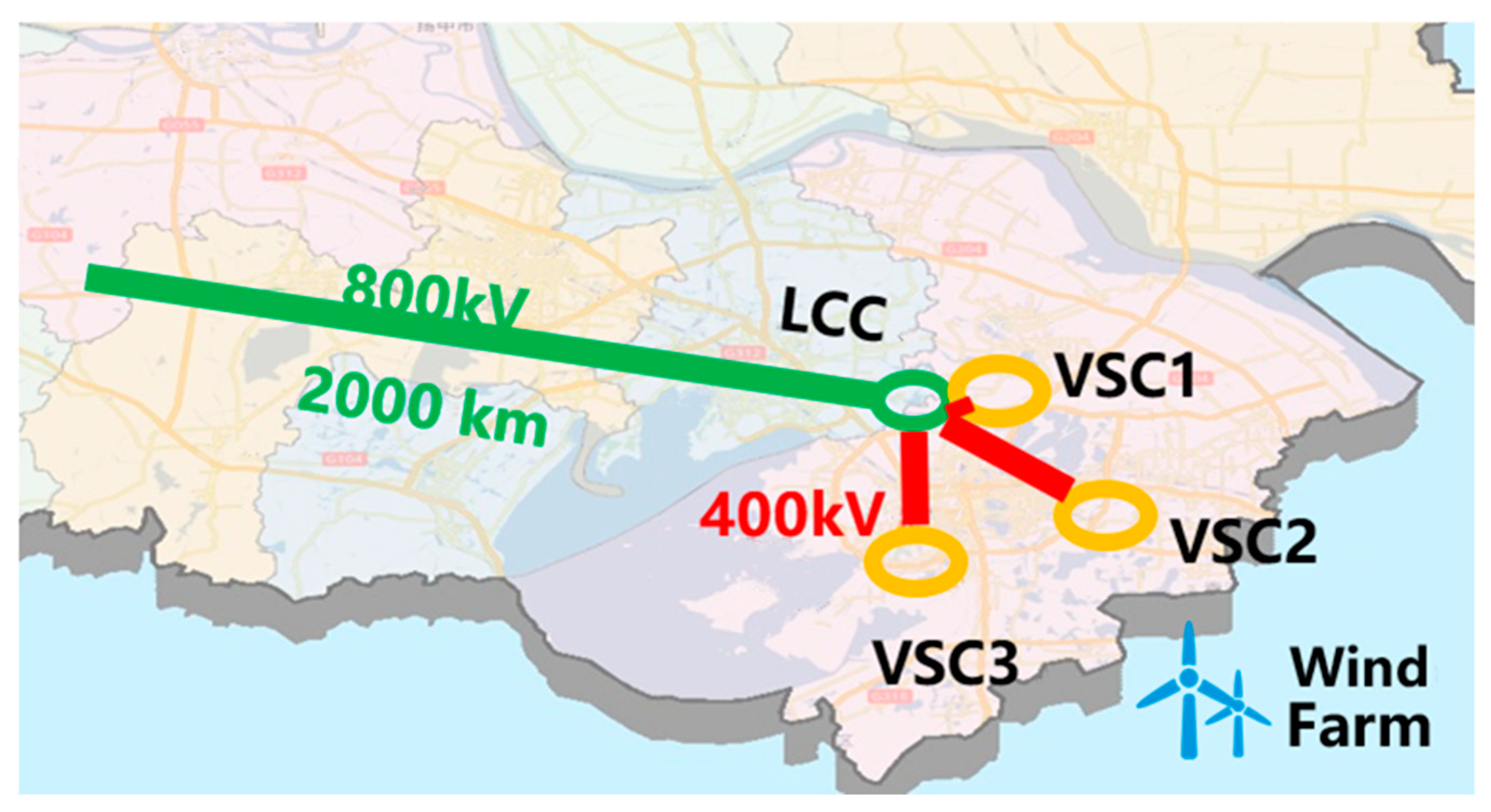



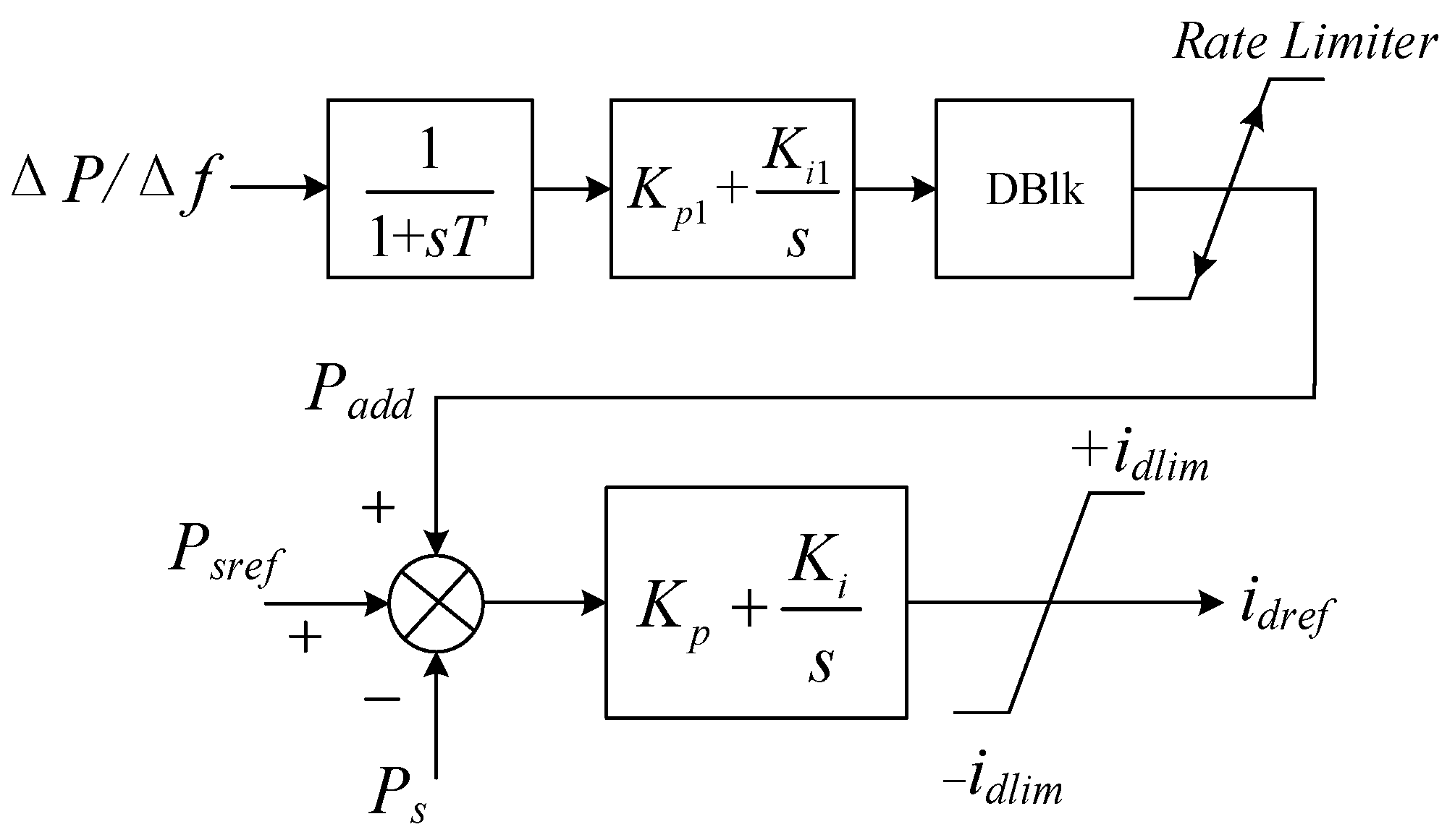
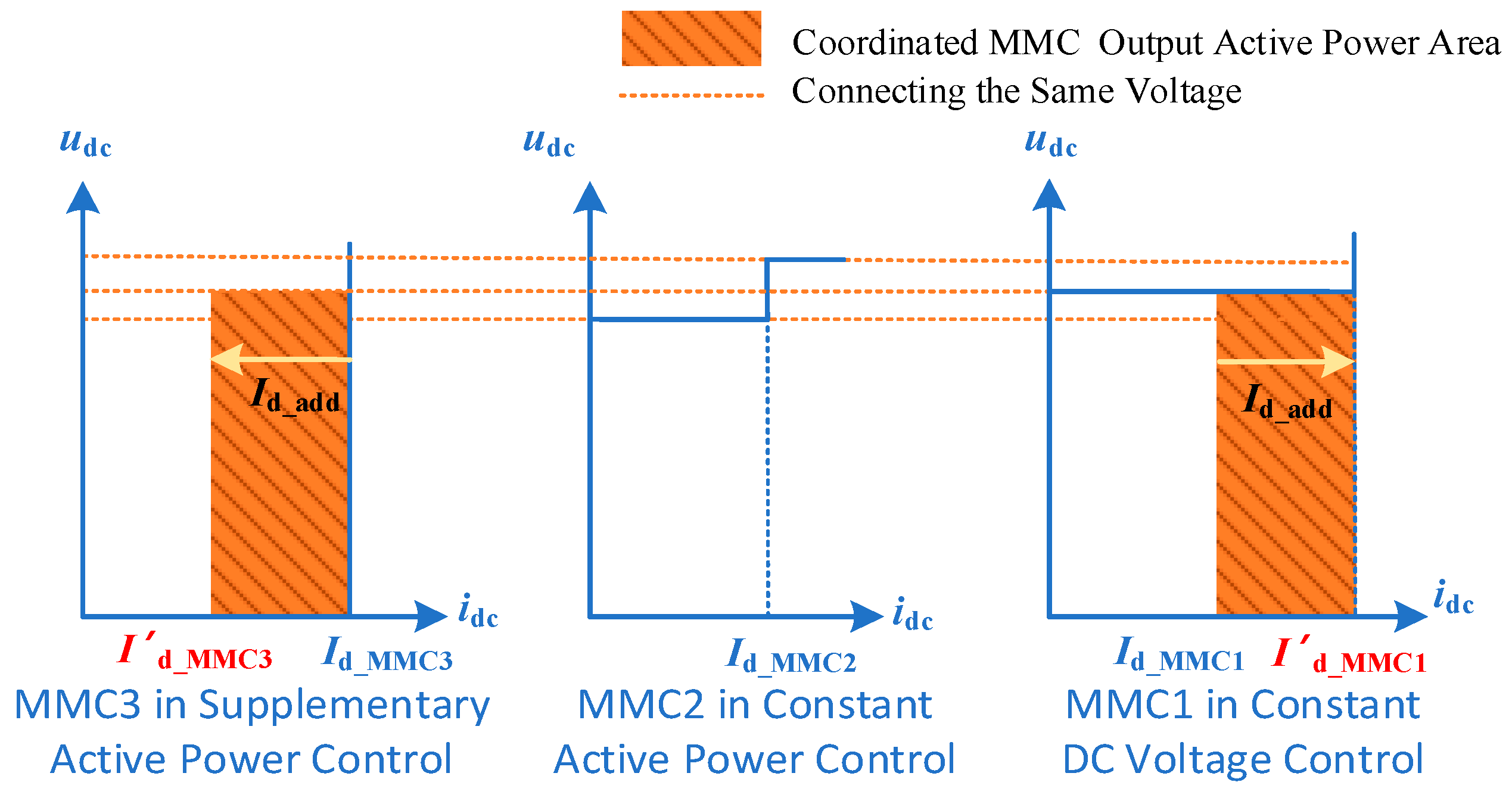
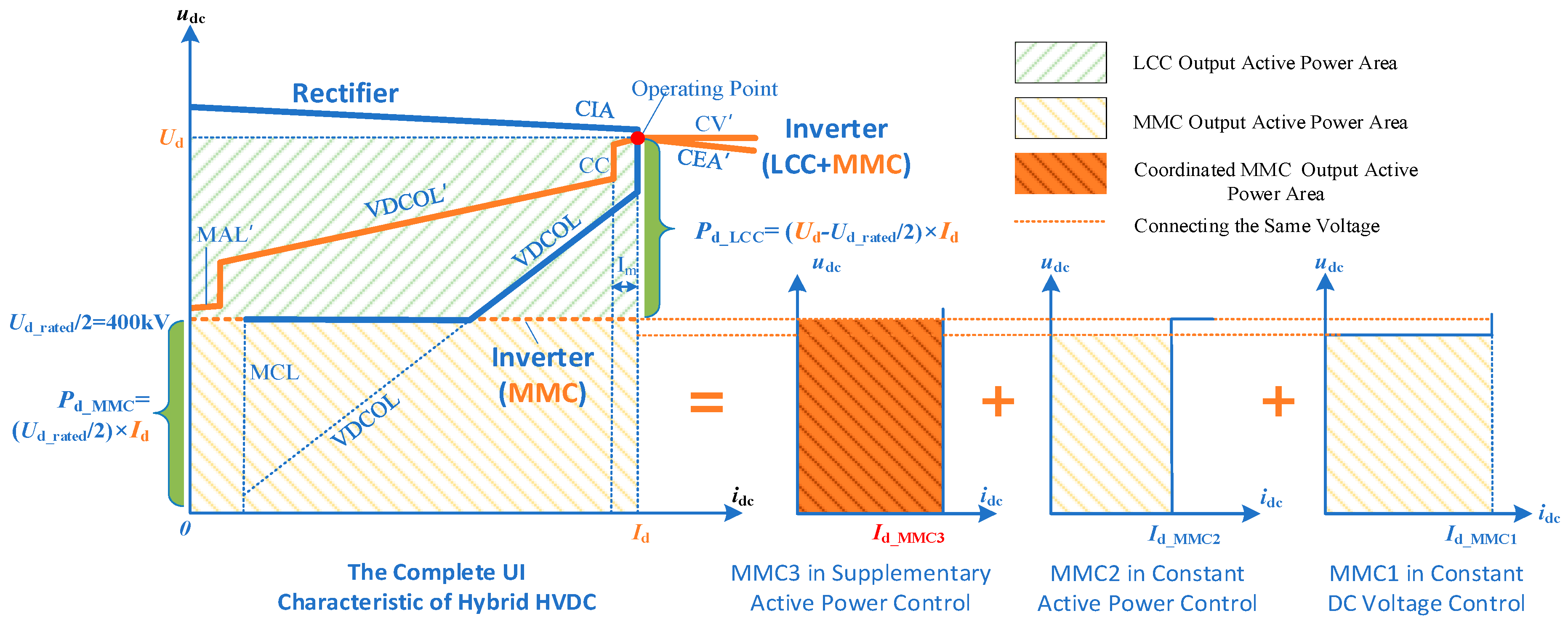
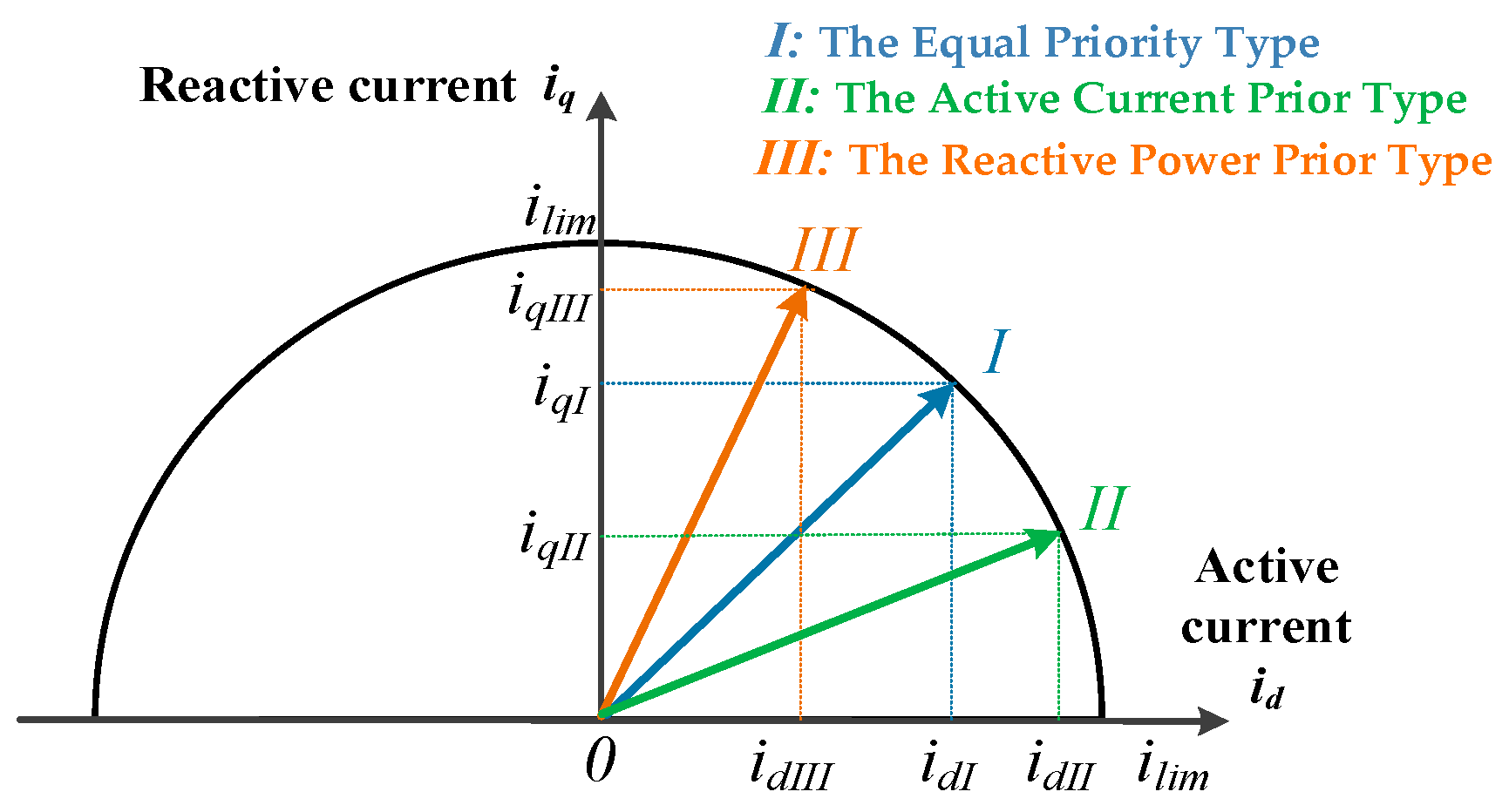
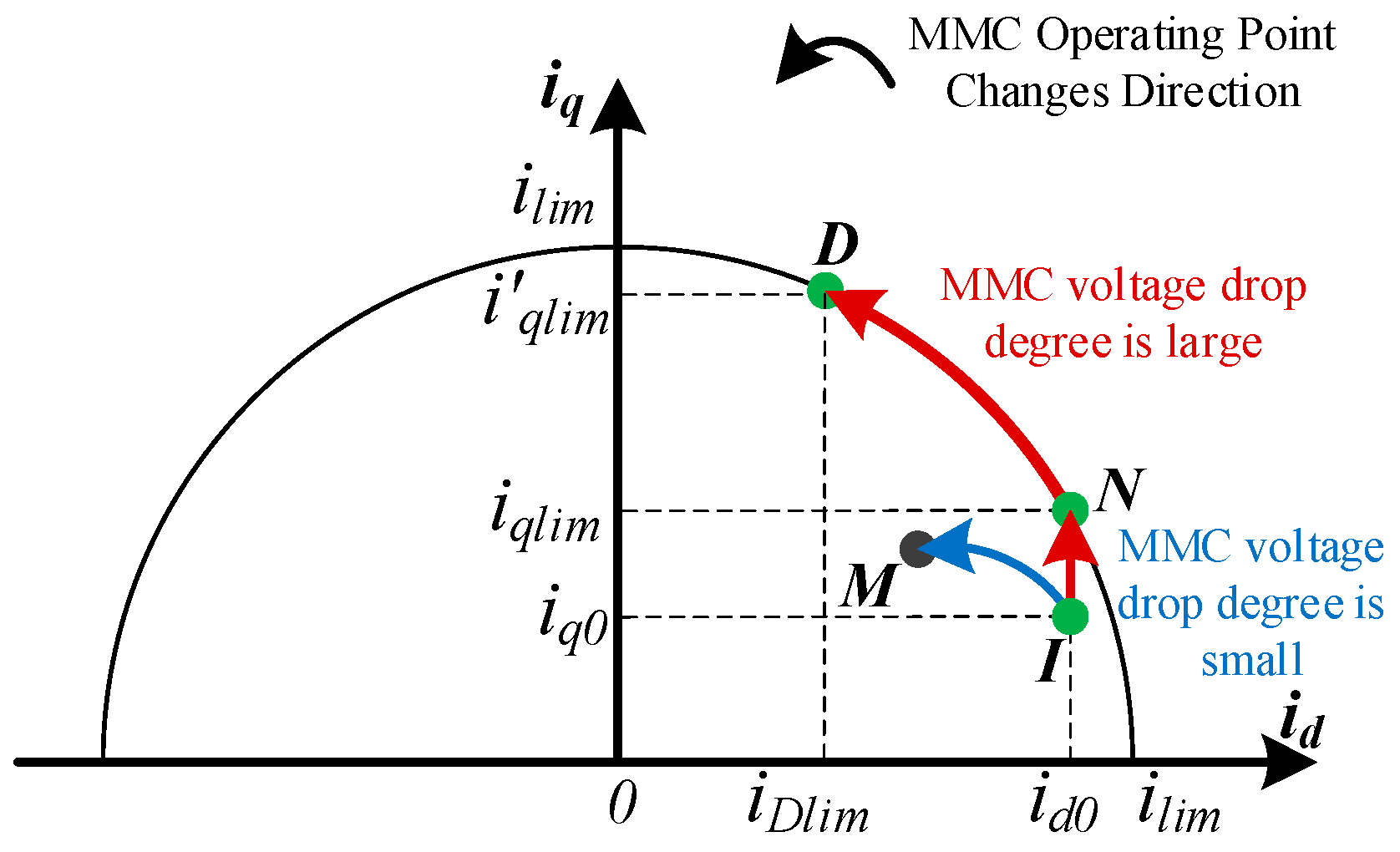

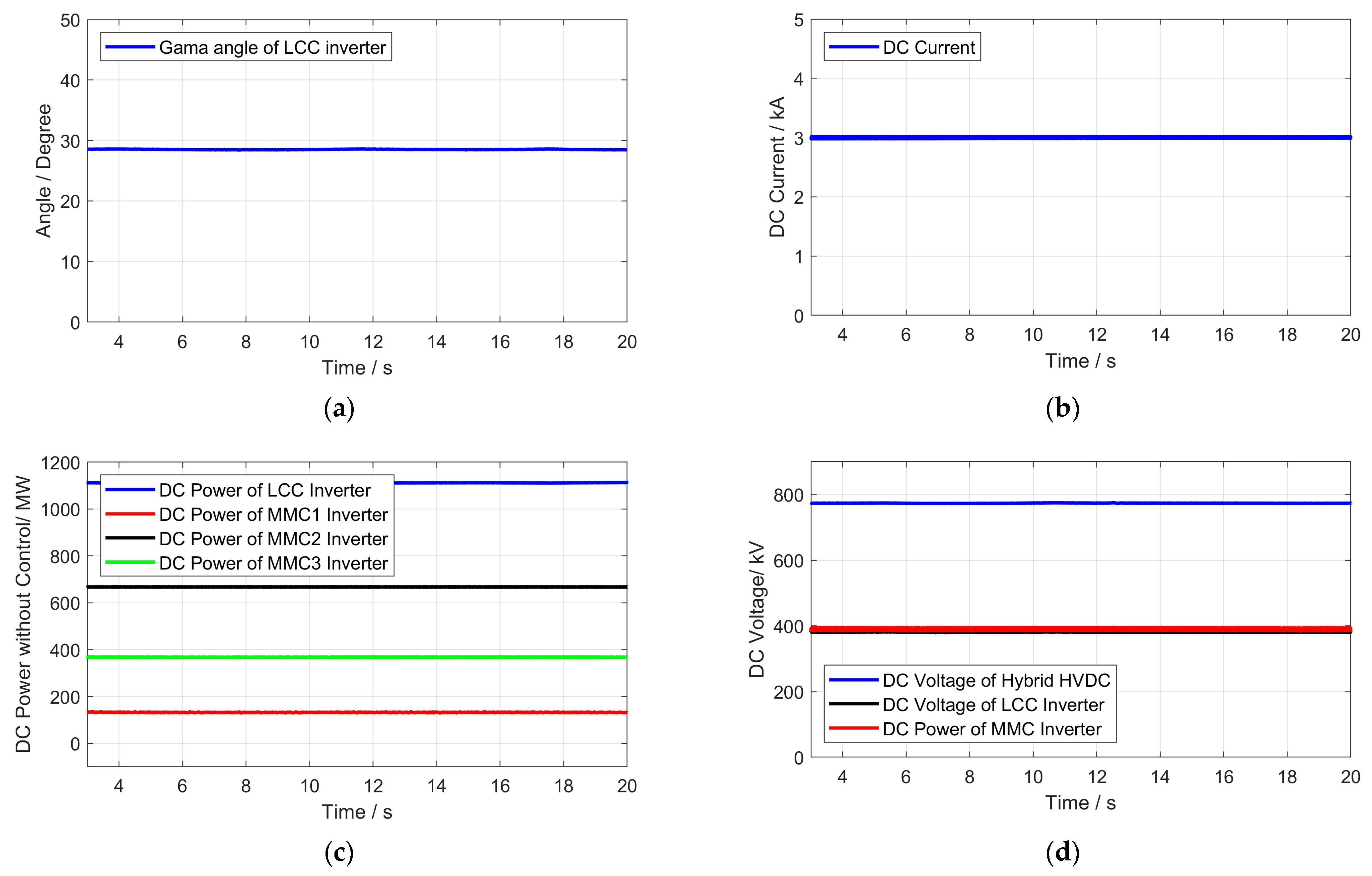


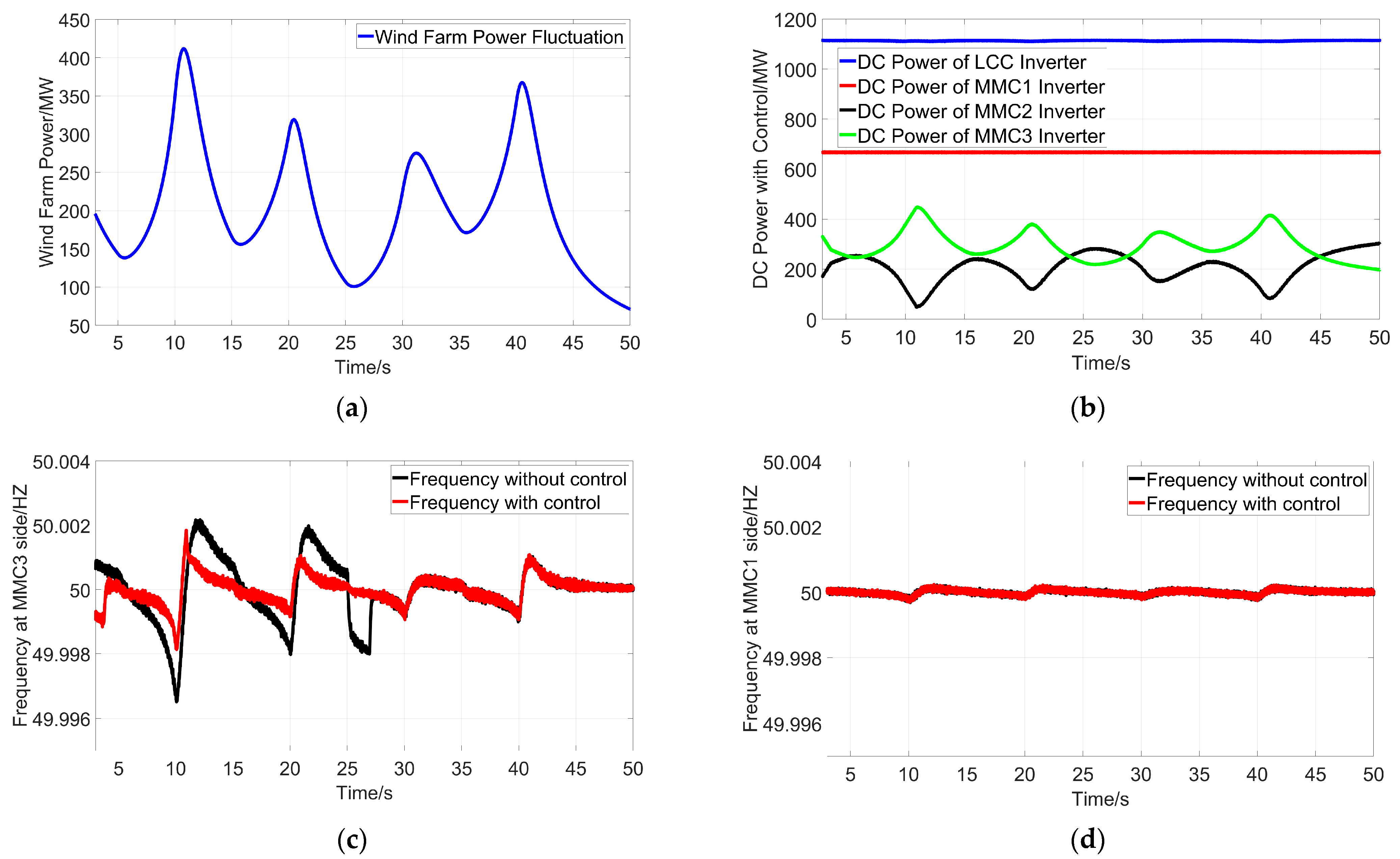

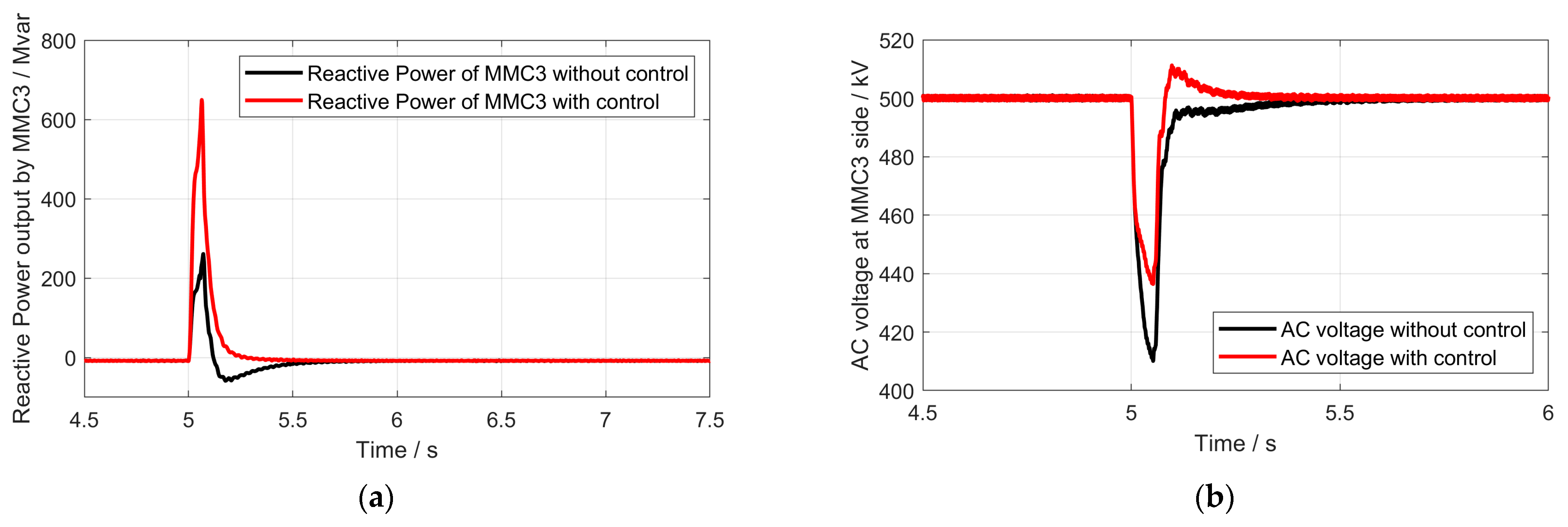
| Part | Parameter | Value |
|---|---|---|
| DC system | direct-current power/MW | 4000 |
| direct voltage/kV | 800 | |
| direct current/kA | 5 | |
| AC system | RMS voltage at rectifier side/kV | 500 |
| RMS voltage at inverter side/kV | 500 | |
| short-circuit ratio at the rectifier side | 5 | |
| short-circuit ratio at the inverter side | 5 | |
| LCC on the rectifier side | direct voltage/kV | 800 |
| direct current/kA | 5 | |
| converter ratio | 500/175 | |
| LCC on the inverter side | direct voltage/kV | 380 |
| direct current/kA | 5 | |
| converter ratio | 500/162 | |
| MMC on the inverter side | direct voltage/kV | 400 |
| direct current/kA | 5 | |
| converter ratio | 500/198 | |
| DC transmission line | length/km | 2000 |
| resistance/Ω | 6.4 | |
| inductance/mH | 1620 |
| Symbol | Control Mode |
|---|---|
| CIA | The Ignition Angle is in Constant Mode |
| CC | The Current Control is in Constant Mode |
| VDCOL | Voltage-Dependent Current Order Limit Control |
| MCL | Minimum Current Limit Control |
| CV | The Voltage Control is in Constant Mode |
| CEA | The Extinction Angle Control is in Constant Mode |
| MAL | Minimum Alpha Angle Control |
| Control Strategy | VSC1 | VSC2 | VSC3 |
|---|---|---|---|
| Active power | CV | CP | CP |
| Reactive power | CAC | CAC | CAC |
Disclaimer/Publisher’s Note: The statements, opinions and data contained in all publications are solely those of the individual author(s) and contributor(s) and not of MDPI and/or the editor(s). MDPI and/or the editor(s) disclaim responsibility for any injury to people or property resulting from any ideas, methods, instructions or products referred to in the content. |
© 2024 by the authors. Licensee MDPI, Basel, Switzerland. This article is an open access article distributed under the terms and conditions of the Creative Commons Attribution (CC BY) license (https://creativecommons.org/licenses/by/4.0/).
Share and Cite
Zhou, T.; Li, Q.; Xu, Y.; Zhao, Y.; Liu, D.; Liu, D. An AC-DC Coordinated Scheme for Cascaded Hybrid High-Voltage Direct Current to Suppress Wind Power Fluctuations. Electronics 2024, 13, 2847. https://doi.org/10.3390/electronics13142847
Zhou T, Li Q, Xu Y, Zhao Y, Liu D, Liu D. An AC-DC Coordinated Scheme for Cascaded Hybrid High-Voltage Direct Current to Suppress Wind Power Fluctuations. Electronics. 2024; 13(14):2847. https://doi.org/10.3390/electronics13142847
Chicago/Turabian StyleZhou, Tingshan, Qian Li, Yufeng Xu, Yizheng Zhao, Deming Liu, and Dong Liu. 2024. "An AC-DC Coordinated Scheme for Cascaded Hybrid High-Voltage Direct Current to Suppress Wind Power Fluctuations" Electronics 13, no. 14: 2847. https://doi.org/10.3390/electronics13142847





